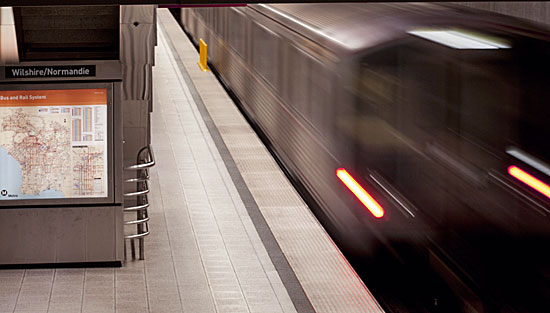Subway gets green light, and a detour
April 27, 2012

The first phase of the Westside Subway, approved this week, will run from Wilshire and Western to La Cienega.
The decades-old dream of building a subway to the Westside of Los Angeles reached a major milestone this week, with the Metro board’s certification of final environmental documents for the project.
The board also approved station locations for the subway’s 3.9-mile first phase, which will extend the Purple Line subway from Wilshire and Western, with stops at La Brea, Fairfax and La Cienega.
But, responding to recent actions taken by the city of Beverly Hills, the board stopped short of approving the entire 9-mile route ending at the Veterans Administration Medical Center in Westwood. Instead, Metro directors voted to postpone a decision on the subway’s final two segments until a hearing can be held to allow Beverly Hills officials to air their concerns about the proposed placement of a station on Constellation Boulevard in Century City, which would require tunneling under Beverly Hills High School.
Beverly Hills requested the hearing under a seldom-used provision of the state’s Public Utilities Code. After the hearing, to be held within the next 30 days, Metro could take up consideration of the final phases of the subway project.
A standing-room-only crowd packed the Metro board’s hearing room Thursday. Many extolled the subway—and the Constellation Boulevard station location—as a job-creating project and much-needed alternative to the traffic-clogged streets around Westside employment centers.
Hilary Norton, executive director of the group FAST (Fixing Angelenos Stuck in Traffic,) reminded the board that a healthy majority of county voters supported taxing themselves to build the subway and projects like it.
“I am here to say thank you for keeping your promise to the 67% of the county’s voters that came to vote for Measure R in support of the Westside Subway,” she said. “For all of us who are parents, who have children and are coming here from these areas outside the study area and need a subway, we ask for your support today.”
But a series of speakers from Beverly Hills said they are worried about the safety of tunneling under the high school property, and about the potential impact on future development plans on the campus. Many said they support placing the Century City station instead on Santa Monica Boulevard—a location that Metro’s scientific experts, including noted seismologist Lucy Jones, say is too dangerous because of active earthquake faults there.
Lisa Korbatov of the Beverly Hills Unified School District Board of Education, a vocal opponent of tunneling under the high school, urged the Metro directors Thursday to closely read reports by experts hired by Beverly Hills. She said it is still possible to “press the re-start button” and reach common ground.
“Let’s have dialogue, open, meaningful, comprehensive communication, and let’s all read the science,” she said.
Added Beverly Hills council member Barry Brucker: “We only ask that science, all the science available, determine the real safety risks and construction challenges, and guide all the important decisions of the Westside extension.”
But Supervisor Zev Yaroslavsky, a member of Metro’s board of directors, said that Beverly Hills’ scientific experts came to “largely the same conclusions that we did—cautioning that we need to be careful and we need to do it right. And we ought to be careful and we ought to do it right.”
“No member of this board of the MTA would want to build a tunnel under any building or under any home in any part of the county of Los Angeles that wasn’t safe,” he added. “But if it’s safe in one part of the county of Los Angeles, it’s safe in every part of the county of Los Angeles.”
Yaroslavsky said he also holds out hope that “problem-solvers” on both sides can get together and work things out, particularly when it comes to making sure that Metro’s plans don’t interfere with future development on the high school campus.
“There is room to talk,” he said, “and there is room to make this work for everyone concerned.”
The Metro board voted 11-1-1 to approve the environmental report and first phase of the subway, with Supervisor Michael D. Antonovich voting no and Supervisor Mark Ridley-Thomas abstaining. Phase one of the subway is expected to break ground next year and to be completed by 2020, although efforts are underway to accelerate that timetable.
Posted 4/26/12












 405 bridge work causes a stink
405 bridge work causes a stink

